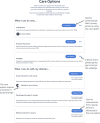A Digital Platform Designed for Youth Mental Health Services to Deliver Personalized and Measurement-Based Care
- PMID: 31507465
- PMCID: PMC6716201
- DOI: 10.3389/fpsyt.2019.00595
A Digital Platform Designed for Youth Mental Health Services to Deliver Personalized and Measurement-Based Care
Abstract
Mental disorders that commonly emerge during adolescence and young adulthood are associated with substantial immediate burden and risks, as well as potentially imparting lifetime morbidity and premature mortality. While the development of health services that are youth focused and prioritize early intervention has been a critical step forward, an ongoing challenge is the heterogeneous nature of symptom profiles and illness trajectories. Consequently, it is often difficult to provide quality mental health care, at scale, that addresses the broad range of health, social, and functional needs of young people. Here, we describe a new digital platform designed to deliver personalized and measurement-based care. It provides health services and clinicians with the tools to directly address the multidimensional needs of young people. The term "personalized" describes the notion that the assessment of, and the sequence of interventions for, mental disorders are tailored to the young person-and their changing needs over time, while "measurement-based" describes the use of systematic and continuing assessment of a young person's outcomes over the entire course of clinical care. Together, these concepts support a framework for care that transcends a narrow focus on symptom reduction or risk reduction. Instead, it prioritizes a broader focus on enhancing social, health, and physical outcomes for young people and a commitment to tracking these outcomes throughout this key developmental period. Now, with twenty-first century technologies, it is possible to provide health services with the tools needed to deliver quality mental health care.
Keywords: ehealth; mental disorders; mental health care; routine outcome monitoring; technology; transdiagnostic; youth.
Figures



Similar articles
-
Right care, first time: a highly personalised and measurement-based care model to manage youth mental health.Med J Aust. 2019 Nov;211 Suppl 9:S3-S46. doi: 10.5694/mja2.50383. Med J Aust. 2019. PMID: 31679171
-
Supporting Clinicians to Use Technology to Deliver Highly Personalized and Measurement-Based Mental Health Care to Young People: Protocol for an Evaluation Study.JMIR Res Protoc. 2021 Jun 14;10(6):e24697. doi: 10.2196/24697. JMIR Res Protoc. 2021. PMID: 34125074 Free PMC article.
-
The effectiveness of web-based programs on the reduction of childhood obesity in school-aged children: A systematic review.JBI Libr Syst Rev. 2012;10(42 Suppl):1-14. doi: 10.11124/jbisrir-2012-248. JBI Libr Syst Rev. 2012. PMID: 27820152
-
Integrated Mental Health Services for the Developmental Period (0 to 25 Years): A Critical Review of the Evidence.Front Psychiatry. 2019 Jun 7;10:355. doi: 10.3389/fpsyt.2019.00355. eCollection 2019. Front Psychiatry. 2019. PMID: 31231250 Free PMC article. Review.
-
Service design for children and young people with common mental health problems: literature review, service mapping and collective case study.Health Soc Care Deliv Res. 2024 May;12(13):1-181. doi: 10.3310/DKRT6293. Health Soc Care Deliv Res. 2024. PMID: 38767587 Review.
Cited by
-
Implementing a digital health model of care in Australian youth mental health services: protocol for impact evaluation.BMC Health Serv Res. 2021 May 12;21(1):452. doi: 10.1186/s12913-021-06394-4. BMC Health Serv Res. 2021. PMID: 33980229 Free PMC article.
-
Causal AI Recommendation System for Digital Mental Health: Bayesian Decision-Theoretic Analysis.J Med Internet Res. 2025 Jun 19;27:e71305. doi: 10.2196/71305. J Med Internet Res. 2025. PMID: 40537067 Free PMC article.
-
'Multi-stressed': A qualitative study exploring the impact of the social determinants of health on access to digital mental health for youth and young adults in Alberta.Digit Health. 2025 Aug 1;11:20552076251361327. doi: 10.1177/20552076251361327. eCollection 2025 Jan-Dec. Digit Health. 2025. PMID: 40761777 Free PMC article.
-
Youth Mental Health Tracker: protocol to establish a longitudinal cohort and research database for young people attending Australian mental health services.BMJ Open. 2020 Jun 7;10(6):e035379. doi: 10.1136/bmjopen-2019-035379. BMJ Open. 2020. PMID: 32513883 Free PMC article.
-
Putting measurement-based care into action: A mixed methods study of the benefits of integrating routine client feedback in coordinated specialty care programs for early psychosis.Res Sq [Preprint]. 2024 Feb 8:rs.3.rs-3918063. doi: 10.21203/rs.3.rs-3918063/v1. Res Sq. 2024. Update in: BMC Psychiatry. 2024 Dec 2;24(1):871. doi: 10.1186/s12888-024-06258-1. PMID: 38405727 Free PMC article. Updated. Preprint.
References
LinkOut - more resources
Full Text Sources

